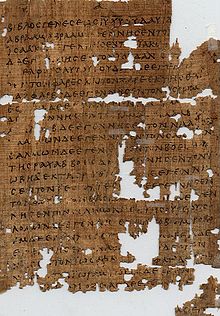
Textual variants in the New Testament
Encyclopedia
Textual variants arise when a copyist makes deliberate or inadvertent alterations to a text being reproduced. Some common alterations include the deletion, rearrangement, repetition, or replacement of one or more words when the copyist's eye returns to a similar word in the wrong location of the original text. If their eye skips to an earlier word, they may create a repetition (error of dittography). If their eye skips to a later word, they may create an omission, or they may resort to performing a slight rearranging of words to retain the overall meaning without compromising the context. In other instances, the copyist may add text from memory from a similar or parallel text in another location. Otherwise, they may also replace some text of the original with an alternative reading. Spellings occasionally change. Synonyms may be substituted. A pronoun may be changed into a proper noun (such as "he said" becoming "Jesus said").
Origen
, writing in the 3rd century, was one of the first who remarked differences between manuscripts of texts that were eventually collected as the New Testament
. He declared his preferences among variant readings. For example, in , he favored "Barabbas" against "Jesus Barabbas" (In Matt. Comm. ser. 121). In , he preferred "Bethabara" over "Bethany" as the location where John was baptizing (Commentary on John VI.40 (24)). "Gergeza" was preferred over "Geraza" or "Gadara" (Commentary on John VI.40 (24) – see ). At Hebrews 2:9, Origen noticed two different readings: "apart from God" and "by the grace of God".
John Mill
estimated the number of variations in the New Testament text at 30,000 based on "nearly 100 manuscripts." Eberhard Nestle
estimated this number as 150,000–200,000 variants. Bart D. Ehrman
has estimated that there are "between 200,000–400,000 variants [in] several million pages of manuscripts."
Since 1981, Greek
New Testament manuscripts have commonly been categorized into five groups
.
An abbreviated list of textual variants in the New Testament is given in this article (below).
Gospel of Matthew

Origen
Origen
Origen , or Origen Adamantius, 184/5–253/4, was an early Christian Alexandrian scholar and theologian, and one of the most distinguished writers of the early Church. As early as the fourth century, his orthodoxy was suspect, in part because he believed in the pre-existence of souls...
, writing in the 3rd century, was one of the first who remarked differences between manuscripts of texts that were eventually collected as the New Testament
New Testament
The New Testament is the second major division of the Christian biblical canon, the first such division being the much longer Old Testament....
. He declared his preferences among variant readings. For example, in , he favored "Barabbas" against "Jesus Barabbas" (In Matt. Comm. ser. 121). In , he preferred "Bethabara" over "Bethany" as the location where John was baptizing (Commentary on John VI.40 (24)). "Gergeza" was preferred over "Geraza" or "Gadara" (Commentary on John VI.40 (24) – see ). At Hebrews 2:9, Origen noticed two different readings: "apart from God" and "by the grace of God".
John Mill
John Mill
John Mill was an English theologian. He is noted for his critical edition of the Greek New Testament which included notes on many variant readings.-Biography:...
estimated the number of variations in the New Testament text at 30,000 based on "nearly 100 manuscripts." Eberhard Nestle
Eberhard Nestle
Eberhard Nestle was a German biblical scholar, textual critic, Orientalist, editor of Novum Testamentum Graece, and the father of Erwin Nestle.- Life :...
estimated this number as 150,000–200,000 variants. Bart D. Ehrman
Bart D. Ehrman
Bart D. Ehrman is an American New Testament scholar, currently the James A. Gray Distinguished Professor of Religious Studies at the University of North Carolina at Chapel Hill....
has estimated that there are "between 200,000–400,000 variants [in] several million pages of manuscripts."
Since 1981, Greek
Greek language
Greek is an independent branch of the Indo-European family of languages. Native to the southern Balkans, it has the longest documented history of any Indo-European language, spanning 34 centuries of written records. Its writing system has been the Greek alphabet for the majority of its history;...
New Testament manuscripts have commonly been categorized into five groups
Categories of New Testament manuscripts
New Testament manuscripts in Greek are categorized into five groups, according to a scheme introduced in 1981 by Kurt and Barbara Aland in Der Text des Neuen Testaments. The categories are based on how each manuscript relates to the various text-types. Generally speaking, earlier Alexandrian...
.
An abbreviated list of textual variants in the New Testament is given in this article (below).
Gospel of MatthewGospel of MatthewThe Gospel According to Matthew is one of the four canonical gospels, one of the three synoptic gospels, and the first book of the New Testament. It tells of the life, ministry, death, and resurrection of Jesus of Nazareth...


